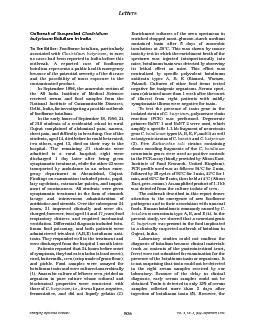

506 LettersOutbreak of Suspected Clostridiumbutyricum Botulism in India To the Editor Foodborne botulism particularlyassociated with Clostridium butyricum is rareno cases had been reported in Indi ID: 848222
Download Pdf The PPT/PDF document "Emerging Infectious DiseasesVol 4 No 3 J..." is the property of its rightful owner. Permission is granted to download and print the materials on this web site for personal, non-commercial use only, and to display it on your personal computer provided you do not modify the materials and that you retain all copyright notices contained in the materials. By downloading content from our website, you accept the terms of this agreement.
1 506 Emerging Infectious DiseasesVol. 4,
506 Emerging Infectious DiseasesVol. 4, No. 3, July–September 1998 LettersOutbreak of Suspected Clostridiumbutyricum Botulism in India To the Editor: Foodborne botulism, particularlyassociated with Clostridium butyricum, is rare;no cases had been reported in India before thisoutbreak. A reported case of foodbornebotulism represents a public health emergenc 507 Vol. 4, No. 3, July–September 1998Emerging Infectious Diseases Letters clinical presentation of the patients, response totrivalent botulinum antitoxin, and isolation oftoxigenic C. butyricum from one of the consumedfood articles strongly suggest that the outbreakwas caused by food contaminated with toxigenicC. butyricum.Neurotoxigenic C. butyricum was firstreported in 1986 in two cases of infant botulism inRome (6). Recently, neurotoxigenic C. butyricumwas isolated from the food implicated in anoutbreak of clinically diagnosed type E botulismin China (7). In this outbreak, it appears thatsevu, because of improper storage, was contami-nated with the spores of C. butyricum, whichsubsequently germinated and produced toxin. Tothe best of our knowledge, this is the first reportof neurotoxigenic C. butyricum causing foodbornebotulism in India.The changing epidemiology of foodbornedisease as highlighted in this report calls forimproved surveillance, including the develop-ment of new technology for identifying outbreaks. We thank Alison East, Institute of Food Research,Reading Laboratory, United Kingdom, for supplying E. coliclones with BONT gene for PCR; Pradeep Seth, professorand head, Department of Microbiology, All India Institute ofMedical Sciences for facilities provided; Biomed Warsaw,Poland, for polyvalent botulinum antitoxin; and the medicaland paramedical staff of Civil Hospital, Ahemdabad. Rama Chaudhry,* Benu Dhawan,* DineshKumar,* Rajesh Bhatia,† J.C Gandhi,‡ R.K.Patel,§ and B.C. Purohit§All India Institute of Medical Sciences, New Delhi,India; †National Institute of Communicable Diseases,Delhi, India; ‡Health Medical Services and MedicalEducation (H.S.), Gandhi Nagar, India; and §CivilHospital, Ahemdabad, Gujrat, India References 1.Hatheway CL. Botulism. In: Balows A, Hausler WJ,Lennette EH, editors. Laboratory diagnosis ofinfectious diseases: principles and practice. New York:Springer-Verlag: 1988. p. 111-33. 2.McCroskey LM, Hatheway CL, Fenicia L, Pasolini B,Aureli P. Characterization of an organism thatproduces type E botulinal toxin but which resemblesClostridium butyricum from the feces of an infant withtype E botulism. J Clin Microbiol 1986;23:201-2. 3.Campbell KD, Collins MD, Ea
2 st AK. Gene probes foridentification of
st AK. Gene probes foridentification of the Botulinal Neurotoxin gene andspecific identification of neurotoxin types B.E. and F.J.Clin Microbiol 1993;31:2255-62. 4.Hatheway CL. Clostridium botulinum and otherclostridia that produce botulinum neurotoxin. In:Hauschild AHW, Dodds KL, editors. Clostridium—ecology and control in foods. New York:Marcel Dekker, Inc.; 1992. p. 3-20. 5.Woodruff BA, Griffin PM, McCroskey LM, Smart JF,Wainwright RB, Bryant RG, et al. Clinical andlaboratory comparison of botulism from toxin types A,B, and E in the United States, 1975-1988. J Infect Dis1992;166:1281-6. 6.Aureli PK, Fenicia L, Pasolini B, Gianfranceschi M,McCroskey LM, Hatheway CL. VII. Two cases of type Einfant botulism caused by neurotoxigenic Clostridium in Italy. J Infect Dis 1986;154:207-11. 7.Meng X, Karasawa T, Zou K, Kuang X, Wang X, Lu C.et al. Characterization of a neurotoxigenic Clostridium strain isolated from the food implicated inan outbreak of food-borne type E botulism. J ClinMicrobiol 1997;35:2160-2. Molecular Analysis of Salmonella A From an Outbreak in NewDelhi, India To the Editor: In the context of emerginginfectious diseases, enteric fever caused bySalmonella paratyphi A deserves increasedattention and vigilance, although its severity isoften milder than that of S. typhi disease.Outbreaks associated with this organism areexceedingly rare but have recently been reportedin India (1) and Thailand. In India, the firstreported outbreak of disease associated with S. A (1) provided an opportunity to studythe molecular epidemiology of infection caused bythis organism.A total of 18 human blood isolates of S. A, 13 from the outbreak in New Delhi,India (from September to October 1996) (1) and 5sporadic isolates from cases unrelated to theoutbreak, were used in this study. A total of 36culture-positive cases were detected during the 6-week outbreak. All strains were phage type 1 andwere sensitive to all antibiotics tested. Isolates wereanalyzed by ribotyping and pulsed-field gelelectrophoresis (PFGE) (2,3). PFGE/ribotype pro-files were assigned arbitrary designations andanalyzed by defining a similarity (Dice) coefficient,F (3), where F = 1.0 indicates complete patternidentity and F = 0, complete dissimilarity.The five sporadic isolates of S. paratyphi Agave PFGE patterns following XbaI (5'-TCTAGA-3') digestion that were unique and distinctlydifferent, with differences of 8 to 12 bands (F =0.63-0.70). In contrast, the 13 outbreak isolatesshared only four closely related PFGE patternsdiffering only in 1 to 6 bands (F = 0.8-1.0). Amongthe outbreak strains, two distinct clones were